Dragon of the fluffy variety. I work with vintage audio tech and sometimes run a Precious Plastic workspace.
Don't wanna be here? Send us removal request.
Text
1997 Compaq RT235BT Pinout and Blind Cable Replacement
I recently picked up this Compaq PS/2 keyboard from my E-waste job in excellent condition. We rarely save keyboards and separate the cords and send them downstream for processing and that was the case with this one. Luckily I found a cut keyboard-less cord from a Wyse KB-9933 to splice on.

The first thing I did was strip the wires and found that the two keyboards used entirely different color codes. Because I had the Wyse PS/2 connector, I could get the pinout, but I found myself in a unique situation with the Compaq without its connector.
I first identified the positive wire by seeing which wire was absolutely needed to power the LEDs and called it a night, worried I fried the chip and would have to go through 25+ combinations.
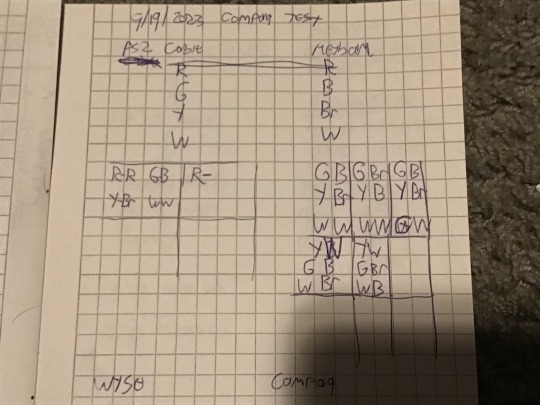
EIGHTY ONE COMBINATIONS LETS GO
The next day I identified the ground wire by looking at where the negative side of the capacitors on the PCB terminated. I found an article with photos of the PCB on the Kazakh tech blog WASP.kz so I didn’t have to do further disassembly.

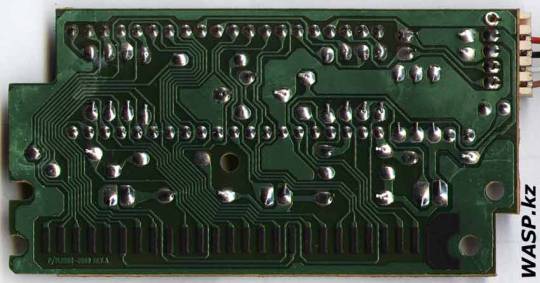
Source: WASP.kz
I had a 50-50 shot on the clock and data wires which I just decided to match by color brightness, and paired yellow and white and brown and green. I also found out that PS/2 peripherals were not intended to be hot swappable so I had to restart my computer to boot it.
It worked! Now I was on my way to a 90’s beige setup I may eventually get around to completing. I then soldered the wires with my very rusty soldering skills, and plugged it in again and it somehow still worked!

The final pinout.
I may revisit this project in the future now that I have another cut PS2 cable of similar vintage and heat shrink solder connectors.
2 notes
·
View notes
Text
A Recording of a Lady
After catching the bug of collecting unusual oddities, you will gain the Eye, and inevitably come across a legitimate treasure. Not an earth shattering one necessarily but something that tells a more satisfyingly complete story than usual, and makes you relieved it wasn’t lost to time….and wonder why it isn’t at least in a local museum.
During my probably unhealthy phase of buying ameteur recordings on eBay and then filing them away, I found this lot. It consisted of an aluminum record, and your typical amateur record faire of the time, a recording of some kid’s christmas pageant from 1951. Alone this would be interesting but I already have one of these and the aluminum record caught my eye.

Aluminum records, particularly the Speak-O-Phone brand typically date from the 20’s and 30’s and were one of the few options available for the general public to hear themselves on their phonograph. With bamboo needles only of course as the steel needles would destroy your record.

But this was not a Speak-O-Phone, this was a Walter C. Garwick, Rye NY record. Looking up this name revealed quite a bit. Walter C. Garwick was a recording engineer who built his own record recorders and recorded primarily for experts in the ethnomusicology field throughout the 30’s. He provided recording service for the America Dialect Society and ethnomusicologist Laura Boulton and designed a record lathe for the Library of Congress. His recordings are mostly held by the Library of Congress and Columbia University and at least a few more in private hands according to one worthpoint post. Here’s a good dive into Mr. Garwick’s life.
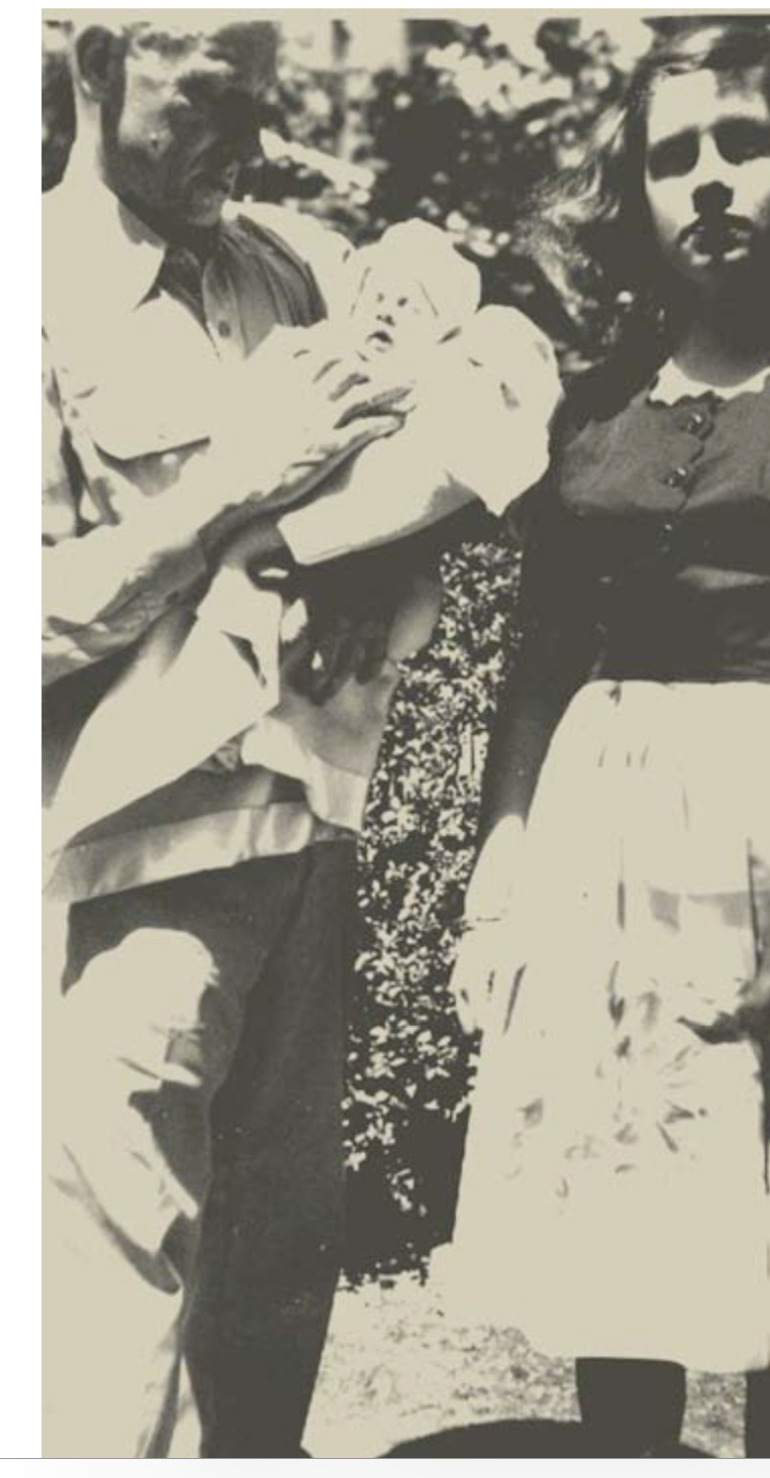
Walter C Garwick in 1945 holding a baby.
source: Christine Whittaker
I knew this had to be one of those so naturally I got it. I didn’t originally notice it but when it arrived I saw that the record sleeve has a note scrawled on it, providing more clues.

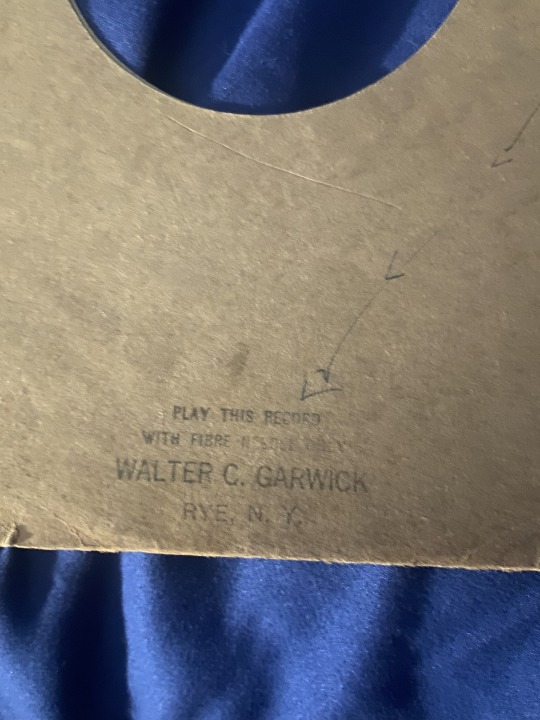

“The Little Half-Chick told by (a name starting with Cl) P. Cope.”
Below there’s a trail of multiple arrows leading the way to the reminder “Play this record with fiber needles only.” Whoever recorded this probably had a frustrating history of people ruining his records with their steel needles and needed MULTIPLE arrows for emphasis. This has got to be the real thing.
The recording features a woman, Ms. Cope, narrating the Little Half-Chick, the Spanish folktale of a flat chicken and how it became the weathervane.
The recording is noisy but her voice comes in very clearly in places. Towards the end a man, possibly a researcher or Mr. Garwick himself, asks “Who is telling this story?” which she responses with an unintelligible first name with her last name, Cope. The man then asks “Ms. Cope, what are you doing…” and then becomes unintelligible.
My next steps from here are to figure out whether the man‘s voice appears in other Garwick recordings and what Ms. Cope’s first name is. I can’t hear what she says and I can’t read the handwriting.
(I was part of the last 3rd grade that learned cursive before my school district splurged and gave us all iPads that everyone broke one week in.)
I could also look into whether physical documentation exists that this recording was made. This is easily my greatest find. Not only is it likely from the 30’s but it can be tied down to a name, and if I’m lucky, a date. I want to ensure its story gets told.
My time with it is probably temporary and as I poke further, I will likely end up donating it somewhere, perhaps joining its brethren at the Library of Congress, a family, or Columbia University.
Here is my recording of both sides on the top of the post. I heeded the warning by using a fiber needle and recorded it with my 1914 Victrola and an iPhone in the horn.
4 notes
·
View notes
Text
CRT Rescue
Just last week I learned that a recycling center near a city I visit was closing down and had over a dozen pallets of CRTs to get rid of. I made arrangements with the owner to stop by on a weekend date. I was especially interested in seeing “IBM terminals” having heard there were about 30 there. Working in the e waste industry myself, it was refreshing to just dive in there and take whatever without looking crazy or violating any regulations. Just the week before about a dozen people came in nerding out over tube TVs. Working in BTB e-waste and being a retro computer nerd is a bad combo, one that is tough on my mental health.
I was also the only person connected with the local Free Geek who could make it so they gave me a shopping list.

I only had an hour to look so I focused on the IBMs. I would learn that IBM at the time used a proprietary “twinax” cable and that these displays could not be connected to anything other than an IBM mainframe. I was able to put together the last two complete units with logic boards. I was disappointed I couldn’t have a VGA ready green 80’s monitor for free, but fortunately I was later told that there were a lot of local IBM mainframe fans around who’d be happy to take them.
I also found a generic TTY terminal from Renyolds and Renyolds with the classic white cursor.

I found a large office paper shredder with a very vintage look that is going to be perfect for Precious Plastic activities through Second Melt, probably the most useful and practical find.
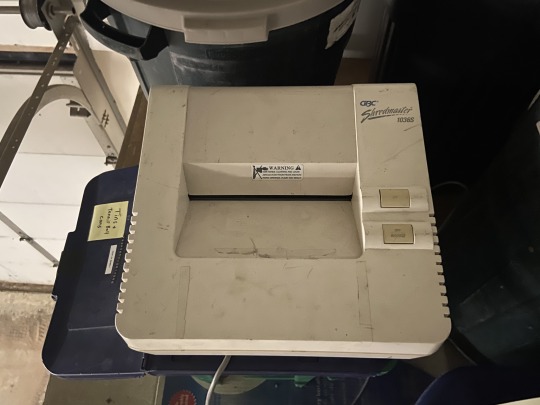
I noticed a large all in one terminal with a mechanical keyboard wedged into a box and decided to turn it on. Fortunately it didn’t blow up but the screen did not do anything. I was hesitant but I decided to grab it for its case and keyboard. If I can’t get it working it will be a great case for when I build my WarGames inspired evil AI.


It is a General Terminal Corporation GTC-100 terminal dating to the early 80’s. After doing some digging I found that it is “teletype compatible” and workable with a USB to 25 pin serial adapter. This one’s a keeper and I’m going to try and restore it.
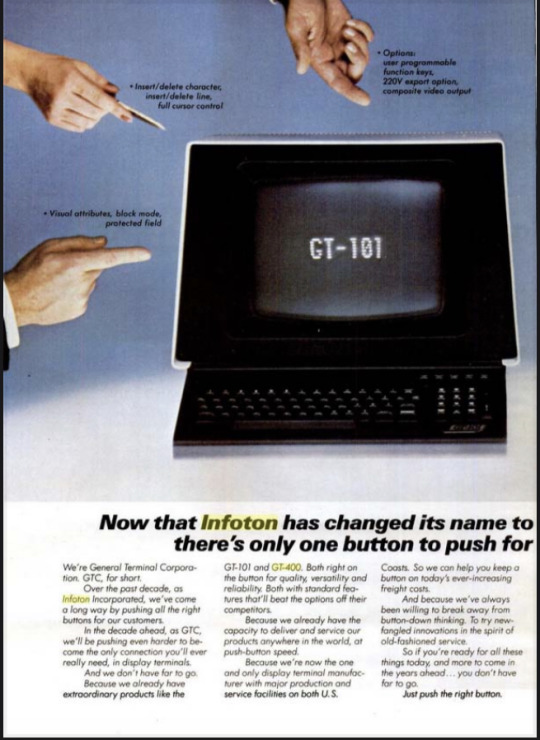
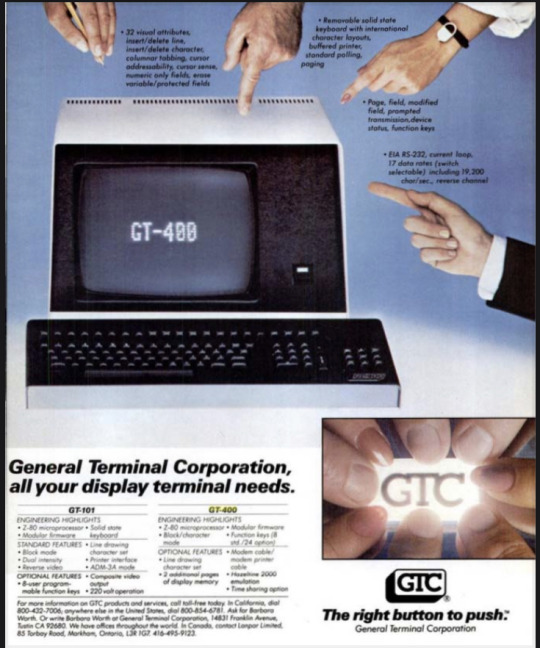
At the last second I grabbed an armful of 9 track IBM tapes, also for donating to the local Free Geek. I’ll keep one for display purposes.

Regretfully I wish I had spent more time there and probably won’t get back— the place has to be cleared out by years end. But I’m empowered I was able to same some stuff to distribute to like minded folks entirely on my own volition. I’m excited to get the terminal working and expect a post, possibly two on that.

6 notes
·
View notes
Text
CRT Rescue
Just last week I learned that a recycling center near a city I visit was closing down and had over a dozen pallets of CRTs to get rid of. I made arrangements with the owner to stop by on a weekend date. I was especially interested in seeing “IBM terminals” having heard there were about 30 there. Working in the e waste industry myself, it was refreshing to just dive in there and take whatever without looking crazy or violating any regulations. Just the week before about a dozen people came in nerding out over tube TVs. Working in BTB e-waste and being a retro computer nerd is a bad combo, one that is tough on my mental health.
I was also the only person connected with the local Free Geek who could make it so they gave me a shopping list.

I only had an hour to look so I focused on the IBMs. I would learn that IBM at the time used a proprietary “twinax” cable and that these displays could not be connected to anything other than an IBM mainframe. I was able to put together the last two complete units with logic boards. I was disappointed I couldn’t have a VGA ready green 80’s monitor for free, but fortunately I was later told that there were a lot of local IBM mainframe fans around who’d be happy to take them.
I also found a generic TTY terminal from Renyolds and Renyolds with the classic white cursor.

I found a large office paper shredder with a very vintage look that is going to be perfect for Precious Plastic activities through Second Melt, probably the most useful and practical find.

I noticed a large all in one terminal with a mechanical keyboard wedged into a box and decided to turn it on. Fortunately it didn’t blow up but the screen did not do anything. I was hesitant but I decided to grab it for its case and keyboard. If I can’t get it working it will be a great case for when I build my WarGames inspired evil AI.


It is a General Terminal Corporation GTC-100 terminal dating to the early 80’s. After doing some digging I found that it is “teletype compatible” and workable with a USB to 25 pin serial adapter. This one’s a keeper and I’m going to try and restore it.


At the last second I grabbed an armful of 9 track IBM tapes, also for donating to the local Free Geek. I’ll keep one for display purposes.

Regretfully I wish I had spent more time there and probably won’t get back— the place has to be cleared out by years end. But I’m empowered I was able to same some stuff to distribute to like minded folks entirely on my own volition. I’m excited to get the terminal working and expect a post, possibly two on that.

#vintage#retro computing#retro gaming#crt monitor#crt tv#1980s#1980s nostalgia#80’s#80s aesthetic#retro aesthetic#ibm#ewaste#e-waste
6 notes
·
View notes
Text
A Recording of a Lady
After catching the bug of collecting unusual oddities, you will gain the Eye, and inevitably come across a legitimate treasure. Not an earth shattering one necessarily but something that tells a more satisfyingly complete story than usual, and makes you relieved it wasn’t lost to time….and wonder why it isn’t at least in a local museum.
During my probably unhealthy phase of buying ameteur recordings on eBay and then filing them away, I found this lot. It consisted of an aluminum record, and your typical amateur record faire of the time, a recording of some kid’s christmas pageant from 1951. Alone this would be interesting but I already have one of these and the aluminum record caught my eye.

Aluminum records, particularly the Speak-O-Phone brand typically date from the 20’s and 30’s and were one of the few options available for the general public to hear themselves on their phonograph. With bamboo needles only of course as the steel needles would destroy your record.

But this was not a Speak-O-Phone, this was a Walter C. Garwick, Rye NY record. Looking up this name revealed quite a bit. Walter C. Garwick was a recording engineer who built his own record recorders and recorded primarily for experts in the ethnomusicology field throughout the 30’s. He provided recording service for the America Dialect Society and ethnomusicologist Laura Boulton and designed a record lathe for the Library of Congress. His recordings are mostly held by the Library of Congress and Columbia University and at least a few more in private hands according to one worthpoint post. Here’s a good dive into Mr. Garwick’s life.

Walter C Garwick in 1945 holding a baby.
source: Christine Whittaker
I knew this had to be one of those so naturally I got it. I didn’t originally notice it but when it arrived I saw that the record sleeve has a note scrawled on it, providing more clues.



“The Little Half-Chick told by (a name starting with Cl) P. Cope.”
Below there’s a trail of multiple arrows leading the way to the reminder “Play this record with fiber needles only.” Whoever recorded this probably had a frustrating history of people ruining his records with their steel needles and needed MULTIPLE arrows for emphasis. This has got to be the real thing.
The recording features a woman, Ms. Cope, narrating the Little Half-Chick, the Spanish folktale of a flat chicken and how it became the weathervane.
The recording is noisy but her voice comes in very clearly in places. Towards the end a man, possibly a researcher or Mr. Garwick himself, asks “Who is telling this story?” which she responses with an unintelligible first name with her last name, Cope. The man then asks “Ms. Cope, what are you doing…” and then becomes unintelligible.
My next steps from here are to figure out whether the man‘s voice appears in other Garwick recordings and what Ms. Cope’s first name is. I can’t hear what she says and I can’t read the handwriting.
(I was part of the last 3rd grade that learned cursive before my school district splurged and gave us all iPads that everyone broke one week in.)
I could also look into whether physical documentation exists that this recording was made. This is easily my greatest find. Not only is it likely from the 30’s but it can be tied down to a name, and if I’m lucky, a date. I want to ensure its story gets told.
My time with it is probably temporary and as I poke further, I will likely end up donating it somewhere, perhaps joining its brethren at the Library of Congress, a family, or Columbia University.
Here is my recording of both sides on the top of the post. I heeded the warning by using a fiber needle and recorded it with my 1914 Victrola and an iPhone in the horn.
4 notes
·
View notes
Text
1997 Compaq RT235BT Pinout and Blind Cable Replacement
I recently picked up this Compaq PS/2 keyboard from my E-waste job in excellent condition. We rarely save keyboards and separate the cords and send them downstream for processing and that was the case with this one. Luckily I found a cut keyboard-less cord from a Wyse KB-9933 to splice on.

The first thing I did was strip the wires and found that the two keyboards used entirely different color codes. Because I had the Wyse PS/2 connector, I could get the pinout, but I found myself in a unique situation with the Compaq without its connector.
I first identified the positive wire by seeing which wire was absolutely needed to power the LEDs and called it a night, worried I fried the chip and would have to go through 25+ combinations.

EIGHTY ONE COMBINATIONS LETS GO
The next day I identified the ground wire by looking at where the negative side of the capacitors on the PCB terminated. I found an article with photos of the PCB on the Kazakh tech blog WASP.kz so I didn’t have to do further disassembly.


Source: WASP.kz
I had a 50-50 shot on the clock and data wires which I just decided to match by color brightness, and paired yellow and white and brown and green. I also found out that PS/2 peripherals were not intended to be hot swappable so I had to restart my computer to boot it.
It worked! Now I was on my way to a 90’s beige setup I may eventually get around to completing. I then soldered the wires with my very rusty soldering skills, and plugged it in again and it somehow still worked!

The final pinout.
I may revisit this project in the future now that I have another cut PS2 cable of similar vintage and heat shrink solder connectors.
2 notes
·
View notes